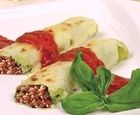|
Italian Entree Cannelloni This beautiful, elegant dish of meat stuffed pasta is topped with two sauces, white cheese and tomato. It requires many steps, but oh! so worth the effort.
Pasta: add water to a large, deep skillet and bring to a boil. Carefully drop noodles into boiling water and cook 3 minutes, or till tender. Do this in batches, removing noodles to linen towels (in a single layer). When cooked, trim noodles to measure 3 1/2" x 4 1/2".* Mornay sauce: melt butter in a saucepan and add flour. Cook over low heat for 2 minutes. Add milk, slowly, stirring till it reaches a boil. Remove from heat; add salt and cheese, continuing to stir till smooth. Set aside. Filling: saute onion and carrot in heavy skillet till onion is translucent, 5-7 minutes. Add pork and beef cubes and brown. Add wine, cover, and simmer for one hour. Using a food processor, blend meat, vegetables, and pan liquid to a smooth paste. Remove to a bowl and add egg yolks, salt, pepper, and 2 T of Parmesan cheese, parsley and 1 C mornay sauce. Assembly: preheat oven to 350. Spread 3 T meat-filling in an even strip down the center of a pasta rectangle. Roll up pasta (lengthwise) and place, seam side down, in a large oiled baking pan. Finish the remaining cannelloni, making 24 rolls in all. Spread the remaining mornay sauce evenly over the top. Then spoon your favorite tomato sauce over that and sprinkle with the remaining 2 T of Parmesan cheese. Bake: for 25 minutes, till sauce is bubbly. Run it under the broiler for a minute to brown the top. Serve immediately. * The little bit of wasted pasta is worth it—easier than homemade pasta. If you want to make your own noodles, cut them to measure 4 x 4. You can also use store-bought manicotti noodles, but Barilla lasagna noodles are is tender, closer to homemade. |
Tips & Glossary Arborio Rice: a medium-grained rice. Its high starch content yields a creamy texture and is the basis for risotto. Balsamic Vinegar: dark, thick vinegar with a sweet pungent flavor. Fermented, concentrated, and aged in wooden casks, sometimes up to 12 years. Can be pricey. Caper: salty, pickled bud of spiny shrub native to the Mediterranean region. Most prized is the non-pareil, the smallest (approx. 1/8”), though other sizes are tasty and less expensive. Formaggio: Cheese! Like France, Italy is a land of sublime cheeses, some 400 varieties. Here are some of the most widely sold in the U.S. Italian Seasoning: blend of dried herbs used in Italian cooking—marjoram, thyme, rosemary, savory, sage, oregano, and basil. Packaged commercially and found in most food stores. You can also make your own. Olive Oil: There's much more to know than is room for here. To learn all you need to know about the different grades of oil, and much, much more, head to Tanbourit. Pine Nuts: pinoli or pignoli; edible seeds of pine trees used in pesto sauce. Before cooking, release flavor by lightly browning in a heated skillet. Roasted peppers: buy or make your own: place under a broiler, or hold over a gas flame, till skin chars and blisters. Place in a closed paper bag for 15-20 minutes (to steam them). When cool, the skins slip off under water. Prosciutto: especially Prosciutto di Parma, dry-cured ham from Parma. The real deal! Cured up to 2 years, is almost sweet and very expensive. You can substitute with capicola, a delicious, light peppery ham.
|
Site by BOOM
![]()
LitLovers © 2024

